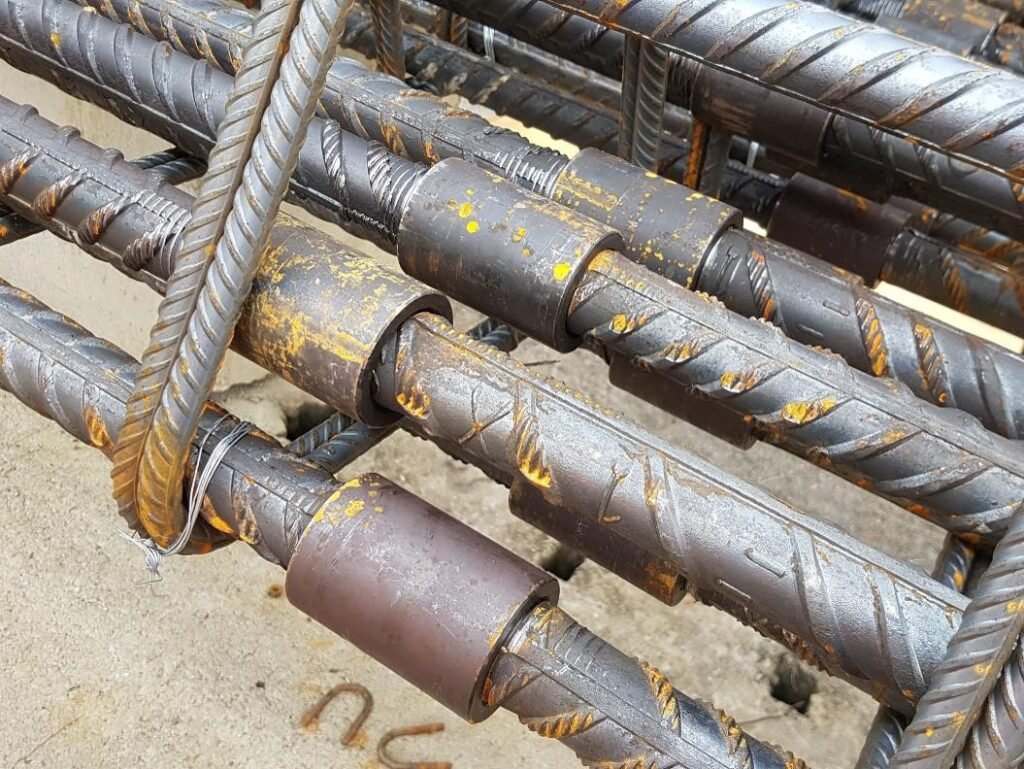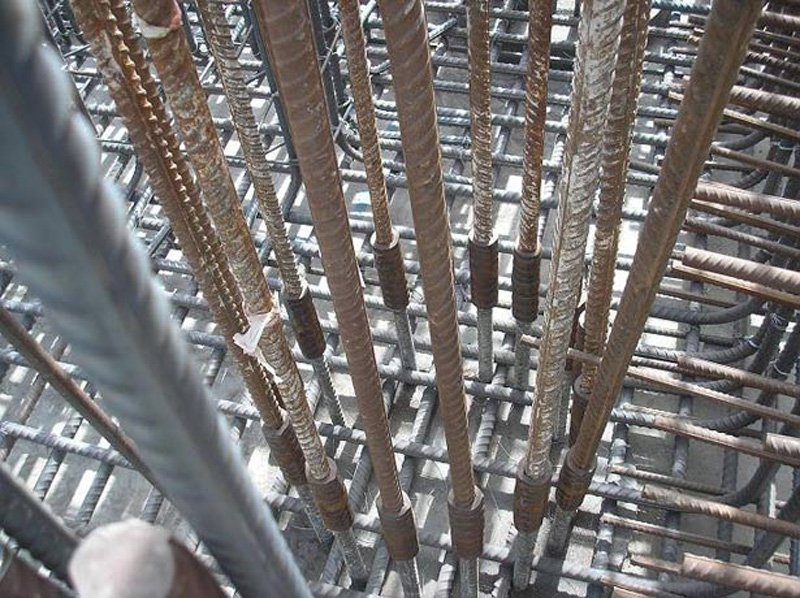In the complex realm of construction engineering, the application of reinforced concrete structures is ubiquitous, with considerations extending beyond mere design to the practicalities of manufacturing and transportation. The incorporation of full-length reinforcement bars in these structures presents formidable challenges, prompting the construction industry to adopt innovative splicing methods. These techniques aim to seamlessly join reinforcement bars, facilitating the effective transfer of forces between them. The crux of concrete structure integrity lies in the precision with which reinforcement bar splicing is designed and executed.
Forces Transfer Mechanism:
The intricate process of force transfer from one reinforcement bar to another predominantly relies on the bonds formed within the concrete. This dynamic involves the initial transmission of force to the concrete from one bar, succeeded by its subsequent transfer to the other bar, establishing a splice through the bond between the reinforcement bars and concrete. This intricate interplay subjects the concrete at the splicing point to elevated shear and splitting stresses, underscoring the critical importance of well-designed splicing in maintaining structural integrity and averting potential cracks.
Methods of Reinforcement Splicing:
Lap Splicing
Lap splicing stands out as the most prevalent and cost-effective method employed in construction projects. In contrast, welded and mechanical splices necessitate a higher level of labor and skill when compared to lap splicing.
When implementing lap splices in reinforcement bars, several crucial considerations must be adhered to:
- Staggered Laps:
- Laps in reinforcement should be staggered for optimal performance.
- Center-to-Center Distances:
- The center-to-center distances of laps should be at least 1.3 times the required lap length of the bars.
- Orientation of Lapped Bars:
- Bars to be lapped should be positioned either vertically, one above the other, or horizontally, side by side.
- Flexural Tension:
- The total lap length, including bends and hooks, in flexural tension should not be less than 30 times the diameter of the bar or the full development length (Ld), whichever is greater.
- Direct Tension:
- Lap length in direct tension should be 30 times the diameter of the bar or 2 times Ld, whichever is greater.
- Tension splices should be enclosed in spirals made from 6mm bars with a pitch not exceeding 100mm, and hooks are to be provided at the end of the tension bars.
- Compression:
- Lap length in compression should be more than 24 or Ld in compression.
- When columns are subjected to bending, the lap length may be increased to the value in bending tension if the bar is found to be in tension.
- Different Bar Diameters:
- When lapping bars with different diameters, the lap length should be calculated based on the diameter of the smaller bar.
- Avoidance of Large Diameter Bars:
- Lap splicing of reinforcement bars exceeding 36mm in diameter should be avoided. If unavoidable, welding is recommended, following special instructions for cold bars if applicable.
- Unusual Circumstances:
- In unusual circumstances, such as splicing in areas with large moments or when more than 50% of bars need splicing, additional closely spaced spirals should be provided around lapped bars, and the lap length should be increased.
- Bundled Bars:
- When splicing bundled bars through lapping, splice one reinforcement bar at a time, staggering the splicing process.
- Non-Compliance and Alternatives:
- If general rules for laps cannot be followed, special welded splices or mechanical connections, as outlined in Cl. 25.2.5.2 of IS 456, should be provided.
It’s essential to note that while lap splices are commonly used, they may lead to congestion issues, demanding alternative splicing methods. Rebar congestion creates critical stress points, hinders concrete flow, and may result in insufficient splice length. Therefore, careful consideration of these factors is paramount in ensuring the structural integrity of reinforced concrete elements.

Mechanical Splice
A mechanical splice in the construction industry refers to the use of a coupler or sleeve to join two reinforcement bars, marking a relatively recent innovation in the Indian construction sector. Mechanical splicing offers several advantages over traditional methods of overlapping:
- Continuous Reinforcement Bar:
- Coupler splicing ensures the creation of a continuous reinforcement bar, effectively avoiding errors associated with incorrect lap lengths in conventional methods.
- Reduction in Steel Wastage:
- Utilizing a mechanical joint minimizes steel wastage by eliminating the need for lap length, resulting in significant savings in steel consumption.
- Dowel Bar Functionality:
- Mechanical couplers can serve as dowel bars, offering a dual-purpose function and concurrently reducing the need for additional formwork material.
- Elimination of Steel Congestion:
- Mechanical joints alleviate concerns related to steel congestion, a common issue in lapping bars, contributing to a more streamlined and efficient construction process.
- Enhanced Design Flexibility:
- Couplers provide greater flexibility for designers, allowing for more intricate and optimized structural configurations.
- Ease of Joint Strength Analysis:
- Mechanical splices, particularly threaded couplers, facilitate a straightforward analysis of joint strength compared to conventional lap joints.

Mechanical couplers are broadly categorized into two types:
Threaded Couplers:
- Tapered Threaded Couplers: Fitted to one end of the threaded rebar, these couplers connect to the adjoining rebar and are tightened using a calibrated torque wrench, a process conducted on-site.
- Roll Threaded Couplers: In this type, bars to be connected are pressed by a set of rollers, and the pressed ends are connected by couplers with matching and parallel threads.
Non-threaded Couplers:
This category encompasses various types suitable for areas where threaded couplers may not be applicable:
- Bolted Couplers
- Friction Weld Couplers
- Welded Couplers
- Swage Couplers
The primary application of non-threaded couplers lies in repair works rather than new construction projects. Despite their higher cost compared to threaded counterparts, they are not extensively employed due to their bulkiness and relatively slow installation process. The choice between threaded and non-threaded couplers depends on project requirements, with each type offering distinct advantages and applications in the realm of reinforcement bar splicing.
Welded Splice
Welded splicing, while not commonly employed due to potential implications on the strength of reinforcement bars, becomes a strategic choice in specific scenarios, necessitating adherence to special conditions and regulations.
Key considerations for welded splicing include:
- Bar Diameter Requirement:
- Welded splicing is typically reserved for rebars with a diameter exceeding 36mm, signifying its application in larger-scale construction scenarios.
- Need for Skilled Labor:
- The utilization of welded splicing is contingent on the availability of skilled labor. If such expertise is lacking, alternative methods are preferred to ensure the precision required for successful implementation.
- Rebar Congestion and Moment Strength:
- Welded splicing finds relevance in areas characterized by rebar congestion and projects demanding heightened moment strength. In such situations, this method is strategically adopted to meet specific structural requirements.
- Weldability of Bars:
- Bars with unfavorable specifications for weldability discourage the use of welded splicing. The method’s appropriateness is contingent on the compatibility of the bars with welding processes to ensure a robust and reliable joint.
- Pre-requisite Assessments:
- Before embarking on welded reinforcement, a comprehensive set of assessments is imperative. This includes a proper chemical analysis of the steel rebars, thorough field inspection, scrutiny of steel quality, and diligent supervision to guarantee the integrity and efficacy of the welding process.

Code Compliance (In the context of IS456 cl.25.2.5 in India):
- The Indian standard IS456 cl.25.2.5 intricately outlines guidelines for reinforcement bar splicing, introducing restrictions based on flexural member considerations and moment constraints.
- Provisions limit the percentage of reinforcement bars that can be spliced at any given section, ensuring a judicious balance between structural stability and splicing efficiency.
- Recommended lap lengths and configurations for various scenarios underscore the importance of meticulous detailing, particularly concerning tension and compression splices.
Conclusion:
Achieving a resilient and enduring reinforcement bar splicing mechanism is imperative for the structural longevity and safety of concrete structures. The selection of splicing methods, be it lap, mechanical, or welded, depends on a multitude of factors, including structural demands, logistical constraints, and material specifications. Adherence to industry standards and codes remains the linchpin for the successful execution of splicing techniques, contributing significantly to the durability and robustness of reinforced concrete structures.


